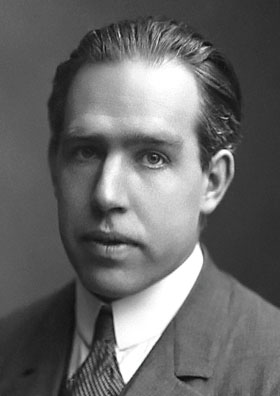

 Niels Bohr, a Danish physicist, was born in Coppenhagen in 1885 and died there in 1962. He was the second son of Christian Bohr, a professor of physiology at the University of Copenhagen, and the brother of Harald Bohr, an eminent mathematician. He graduated from the Coppenhagen University in 1908, where in his second year he worked as a professor’s assistant. Still an undergraduate in 1907, he was awarded golden medal for his essay by the Royal Danish Academy of Sciences and Letters. He defended his PhD thesis on the electron theory of metals in 1910. In 1911 and 1912 he worked in Cambridge for a few months with J. J. Thomson in the Cavendish Laboratory. Then he spent three years intermittently in Manchester studying radioactive emissions. In 1916 he was appointed professor of Copenhagen University. In 1921 he became director of the Institute of Theoretical Physics, now known as Niels Bohr Institute, established especially for him, and from 1922 he was dispensed from giving his lectures at the university.
Niels Bohr, a Danish physicist, was born in Coppenhagen in 1885 and died there in 1962. He was the second son of Christian Bohr, a professor of physiology at the University of Copenhagen, and the brother of Harald Bohr, an eminent mathematician. He graduated from the Coppenhagen University in 1908, where in his second year he worked as a professor’s assistant. Still an undergraduate in 1907, he was awarded golden medal for his essay by the Royal Danish Academy of Sciences and Letters. He defended his PhD thesis on the electron theory of metals in 1910. In 1911 and 1912 he worked in Cambridge for a few months with J. J. Thomson in the Cavendish Laboratory. Then he spent three years intermittently in Manchester studying radioactive emissions. In 1916 he was appointed professor of Copenhagen University. In 1921 he became director of the Institute of Theoretical Physics, now known as Niels Bohr Institute, established especially for him, and from 1922 he was dispensed from giving his lectures at the university.
The Niels Bohr Institute became the international meeting point for physicists, and played an indispensable role in nuclear research and in the development and adaptation of quantum theory. In 1943, after having been informed that he was in danger of being arrested (her mother had been a Jew) The Danish resistance helped Bohr escape to Sweden, then he was received in England and later in the United States. Only after the World War II could he return to the „capitol of nuclear physics”. The most prominent nuclear physicists spent varying amount of time in his company for the benefit of themselves and science.
Almost all nuclear physicists of the world kept contact with the school established by Bohr. He was member of the Danish Royal Society from 1917 and its President from 1939. More than 20 academies elected him a member, among these the Hungarian Academy of Science in 1938. He received Nobel prize in 1922 for „the investigation of the structure of atoms and of the radiation emanating from them”.
Bohr’s paper „On the constitutions of atoms and molecules” in 1913 paved the way to modern atomic theory. In this study he adapted Rutherford's nuclear structure to Max Planck's quantum theory. He supposed that electrons can travel only in particular orbits around the atom's nucleus, which is determined by the spin (angular momentum) of the electrons. He further hypothesized that each orbit represents a particular energy level, and when an electron drops from a higher-energy orbit to a lower one, it radiates energy (a quantum of discrete energy) that equals to the difference between these energy levels. He managed to explain the line spectrum of the hydrogen atom by the series of Bohr assumptions (quantum assumption and frequency assumption). In this way he established a relation between the constitution of the atom, spectroscopy and quantum theory. At the same time the success of the theory gave a boost to further development of quantum theory.
In 1933 he developed a model for nuclear fission with Wheeler. The liquid-drop model of the atom worked out at that time proved to be useable in the explanation of many atomic phenomena. He conceived the so-called correspondence principle in 1916. It states that the behavior of systems described by the theory of quantum mechanics (or by the old quantum theory) reproduces classical physics in the limit of large quantum numbers. In 1927 he presented the complementarity principle, which states that the corpuscule and the wave are the complementary, physical properties of the same phenomenon. His son, Aage Bohr (1922-2009) was also a Nobel Prize winner physicist.